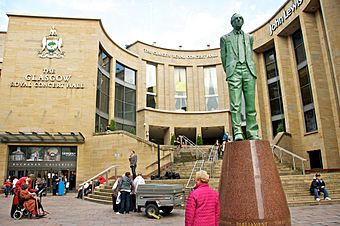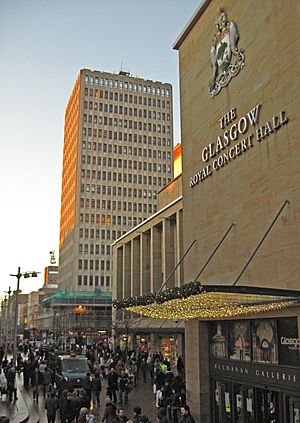Glasgow Royal Concert Hall facts for kids
|
Glasgow International Concert Hall
|
|
 |
|
| Address | 2 Sauchiehall Street G2 3NY Glasgow, Scotland |
|---|---|
| Owner | Glasgow City Council |
| Operator | Glasgow’s Concert Halls |
| Type | Concert hall |
| Capacity | 2,475 (Main Auditorium) 500 (Strathclyde Suite) 300 (Lomond Foyer) 300 (Clyde Foyer) 300 (Exhibition Hall) 120 (Buchanan Suite) |
| Construction | |
| Opened | 1990 |
| Years active | 1990 - Present |
| Architect | Sir Leslie Martin |
The Glasgow Royal Concert Hall is a large and important building in Glasgow, Scotland. It is a major place for music, shows, and other arts events. The city of Glasgow owns this hall. It is managed by Glasgow Life, which is a part of Glasgow City Council. Glasgow Life also runs other famous venues in the city, like the City Halls and Old Fruitmarket.
Contents
History of the Concert Hall
The idea for the Royal Concert Hall started as the Glasgow International Concert Hall. It is one of the biggest halls in the United Kingdom. It officially opened its doors in October 1990.
This new hall replaced the old St. Andrews Hall. That hall was sadly destroyed by a fire in 1962. The city built the new Concert Hall for a special reason. Glasgow was chosen as the European City of Culture in the 1980s. This meant Glasgow was recognized for its amazing arts and culture.
The Concert Hall is located where Buchanan Street and Sauchiehall Street meet. Performers use an entrance on West Nile Street. The public can enter from Buchanan Street and Killermont Street. Later, the RSNO Centre was added nearby. The building was also planned near a big shopping mall called Buchanan Galleries.
A clever design feature helps keep the hall quiet. A huge rubber layer is built into the floor of the main auditorium. This layer stops noise and shaking from the Subway trains running underneath.
The Princess Royal officially opened the Glasgow International Concert Hall on October 5, 1990. The Royal Scottish National Orchestra played the first concert. This was a big event for Glasgow as the European City of Culture. They played new music by Scottish composers and pieces by Beethoven and Vaughan Williams. The day before, public concerts were held to raise money for the RNLI. These concerts also showed how the stage could change for different shows. The first non-classical concert was by a band called The Blue Nile. Later, the hall was given "Royal Status" and renamed the Glasgow Royal Concert Hall.
Building Design
The building was designed by a famous architect named Sir Leslie Martin. He was known for his modern designs. The Edinburgh-based company RMJM and partners also helped with the project in 1988.
Performance Areas and Facilities
The Main Auditorium is the biggest space in the Glasgow Royal Concert Hall. It can hold 2,475 people for a show. There are other smaller spaces too. The Strathclyde Suite can hold 500 people. The Exhibition Hall holds 300, and the Buchanan Suite holds 120. The Lomond and Clyde foyers can each hold 300 people.
The hall also has a gift shop, five bars, and a café. It is also the main home for the Royal Scottish National Orchestra.
The Green Room used to be a fancy dining room. In 2009, it was updated and renamed "The City of Music Studio." This was to celebrate Glasgow being a UNESCO City of Music. This studio is known for its view of Buchanan Street and its late-night jazz music. The Cafe Bar was also updated in 2011 and is now called Café Encore.
The Royal Scottish National Orchestra recently moved into a new, special home right next to the hall. You can enter it from Killermont Street. Their new home has a 600-seat auditorium. This space can be adjusted for sound. It's great for rehearsals and recording music. The Royal Scottish National Orchestra Centre also has a special learning space. It is called the Robertson Learning and Engagement Centre.
In July 2015, a special digital organ was put into the hall. It is a Copeman Hart organ with four manuals.
Important Events
The Hall is where the Royal Scottish National Orchestra often performs in Glasgow. Many famous orchestras and musicians from around the world have played here. These include the Royal Concertgebouw Orchestra and the Saint Petersburg Philharmonic Orchestra. Young musicians from the National Youth Orchestras of Great Britain and Scotland have also performed. Famous soloists like Celia Bartoli, Julian Lloyd Webber, and Maxim Vengerov have played here too.
Besides classical music, the hall hosts many other types of shows. You can see opera and ballet, musical theatre, talks, rock and pop concerts. Folk, world, country, swing, and comedy shows also take place here. The hall also displays art and photo exhibitions. It is even used for graduation ceremonies for students from the nearby Glasgow Caledonian University.
On October 9, 1993, Nelson Mandela visited Glasgow. He chose Glasgow to formally receive the "Freedom of the City" from nine British cities. He entered the hall while a choir sang Down by the Riverside. Everyone gave him a standing ovation. In 1994, Bob Hope performed on stage. He was there to remember the 50th anniversary of the D-Day landings.
The Hall is the main place for the yearly Celtic Connections Festival. It is also one of the venues for Glasgow's Aye Write Book Festival.
See also
 In Spanish: Real Sala de Conciertos de Glasgow para niños
In Spanish: Real Sala de Conciertos de Glasgow para niños


